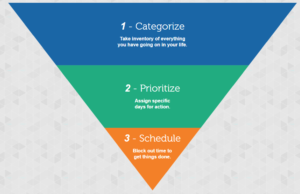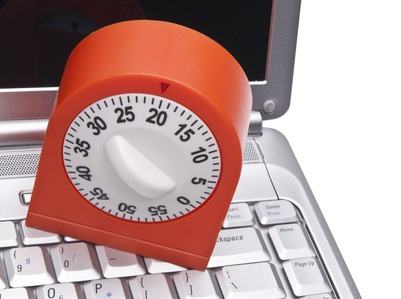It’s 9:32am, and you are in your office. You just got off the phone with a client and have notes to deal with, you have a staff meeting at 10:00, you have 2 phone messages, the board meeting you are in charge of is in 3 days, your manager asked when the report she is waiting on will be done, and you need to make an appointment to get your oil changed. What do you work on right now?
How many times a day do you find yourself in a situation similar to this? Without clear priorities and a defined plan, we often find ourselves doing the wrong things or wasting time that could be spent on productive tasks. Email….Facebook…internet rabbit trails…urgent but low priority tasks…sound familiar?
Following are 3 important steps to take to be sure you are making the right choices with your time.
Step 1: Know your values and set clear goals and priorities.
Are you clear on your business and life goals and priorities? Without this basis, it is impossible to know whether you’re spending time on the “right” things? Set aside 20-30 minutes with a blank sheet of paper. Divide the paper into 5-7 categories, specific to your life and career, and determine 1-3 annual goals or priorities within each category. Keep this paper handy to refer to weekly, or even daily, as you plan your time.
Step 2: Schedule in weekly planning and daily review.
I recommend doing your weekly planning on Sunday evening or Monday morning. Based on the high-level categories and goals developed above, determine what your priority tasks are for the week. Use this time as a “brain dump” to get everything off your mind on paper (or in electronic form). Once you have a list of prioritized tasks for the week, that tie to your goals and values, determine where they fit into your calendar. In other words, what day will you work on the task? Is there a deadline you are working towards? Will it require time-blocking in your calendar? Drilling down to this daily task list will help you to determine if you will be able to reasonably accomplish your tasks within that week. You may decide to push a task into the future based on this. A tool that I like for this step is The Planner Pad, a planner created to work as a funnel for your tasks as described here.

At the beginning of each day, take a few moments to review your plan and make any needed changes.
Step 3: Determine “What will I work on right now?”
At every moment, you have three options for what to spend your time on:
-
- Predefined work from your planning time above. In other words, tasks from your Step 2 planning. If you’ve done some time-blocking, you may already have an activity scheduled. Otherwise, take a quick look through your task list for the day and choose the one that makes the most sense at that point in time. Take into account the length of time you have – will you choose a short task to fill the 15 minutes before a meeting or will you choose a more focus-intensive task with an hour or more of available time. Evaluate your environment. Tasks in a quiet office or other location may differ from those in a noisy coffee shop.
- Work as it shows up. Any new work that shows up should be evaluated for priority and placed into your system as appropriate.
- Defining/processing work. This includes managing email, returning phone calls, filing or scanning, and your weekly and daily planning. It is important to schedule time in your day for these tasks.
When making the decision as to what to work on at any given point in time, a question you can ask is,” What will give me the highest payoff?” Sometimes it comes down to intuition based on the work and planning done in the three steps above. As an example, I knew via my weekly planning that I had a goal to work on my newsletter today. When I came to a time in my day in which I had one hour, in a quiet location, I decided to use that time to focus on writing this article.
While your days and weeks will not always go completely as planned, your preplanning via collection and processing should give you the comfort to make the right decisions at each point in time and trust in your actions. As David Allen, productivity expert and author of Getting Things Done, says, “You have more to do than you can possibly do. You just have to feel good about your choices.”


Recent Comments